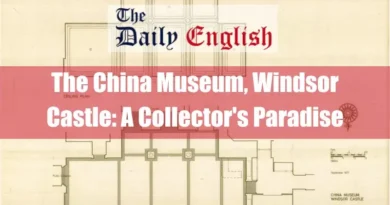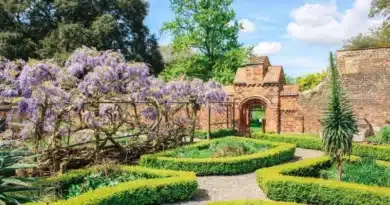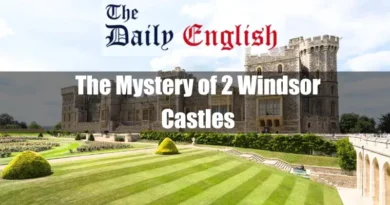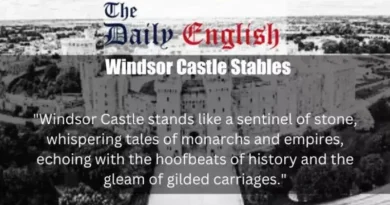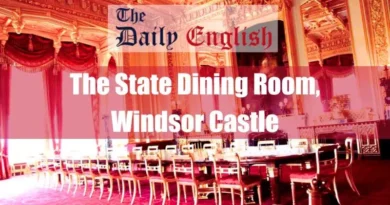I. Introduction
Tucked within Windsor Castle are the Semi-State Rooms, epitomes of royal heritage and architectural splendour. Created for George IV by architect Sir Jeffry Wyatville in the 1820s, they link to Britain’s regal past, offering a glimpse into the opulent life of royalty. They have hosted numerous historic events, from royal weddings to state banquets.
The Semi-State Rooms feature exquisite interiors by Morel & Seddon, adorned with furnishings from Carlton House, George IV’s former residence. Designed to impress, these rooms showcase the finest craftsmanship, artistry, and design, making them a true jewel in Windsor Castle.
II. History of The Semi-State Rooms

A. A Historical Background of Windsor Castle
Windsor Castle’s rich history provides context to the creation of the Semi-State Rooms. Let’s delve into its development through different eras.
Origins and Early Construction (11th Century – 18th Century)
- 1070s: William the Conqueror, following the Norman conquest of England, begins constructing a motte-and-bailey fortification on the site of what would become Windsor Castle.
- 12th—16th Centuries: Under successive monarchs, the Castle underwent significant expansion and transformation. Henry II established a stone keep, and later monarchs like Henry III and Edward III added royal apartments, a chapel (St. George’s Chapel), and a Great Hall.
- 17th—18th Centuries: The Castle primarily served as a hunting lodge for the monarchs. However, Charles II undertook some modernisation efforts, including improvements to the State Apartments.
Development through Monarchic Eras
- Georgian Era (1714 – 1830): This period witnessed a renewed focus on Windsor Castle as a royal residence.
- George III acquired Buckingham House 1761 for Queen Charlotte and used other residences like Kew Palace and Windsor Castle.
- George IV embarked on a grand renovation project under architect Jeffry Wyatville. This included remodelling the Castle’s exterior for a more romantic aesthetic and commissioning the creation of a new suite of private rooms on the sunnier east side: The Semi-State Rooms.
B. Creation of the Semi-State Rooms (1820s)
- Monarch: George IV
- Architect: Sir Jeffry Wyatville
- Significance: These rooms represent George IV’s final and grandest interior design project.
- Style: The design of the Semi-State Rooms was influenced by Greek and Roman models and the Regency style popular in the early 19th century, which included some exotic touches such as Egyptian and Chinese motifs.
C. Later Developments and Challenges
- 19th Century: The Semi-State Rooms became a favoured space for the British Royal Family to entertain guests.
- 1992: During the fire in 1992, efforts were made to save as many contents as possible from the Semi-State Rooms, although not all could be removed before the fire caused significant damage.
- Restoration: Following the fire, a careful restoration effort ensured the rooms were returned to their original 19th-century glory using original design plans.
D. Current Use
Today, the British Royal Family still uses the Semi-State Rooms for official entertaining, particularly during the autumn and winter. When not used for royal events, the rooms are occasionally open to the public for tours, offering visitors a glimpse into this rich and historically significant space.
III. Architectural Features of The Semi-State Rooms

A. Design Influences and Architects
The Semi-State Rooms, commissioned by King George IV in the 1820s, reflect his refined taste and penchant for grandeur. Sir Jeffry Wyatville, a prominent architect of the Regency period, was the visionary behind their creation. Wyatville incorporated various design influences, including:
- Classical Antiquity: The rooms feature elements inspired by Greek and Roman architecture, such as symmetrical layouts, columns, and decorative friezes.
- Regency Style: The Regency style, prevalent in the early 19th century, is characterized by elegance and classical details. These rooms exhibit this style. Wyatville blended classical influences with exotic touches, incorporating hints of Egyptian and Chinese motifs into the decorative details.
B. Interior Decor and Furnishings
Morel & Seddon, a leading design firm of the Era, was entrusted with bringing Wyatville’s vision to life. They crafted opulent interiors characterised by:
- Lavish Ornamentation: Elaborate plasterwork adorned the ceilings, while rich silks and damasks adorned the walls. Gilt accents and painted panels further accentuated the luxurious feel.
- Exquisite Furnishings: Exquisite furniture, much of it brought from Carlton House, George IV’s former London residence, filled the rooms. These included gilded chairs, settees, and cabinets, often crafted from precious woods and upholstered in delicate fabrics.
IV. Notable Features and Artifacts

A. The Grand Reception Room
Architecture and Design Elements
The Grand Reception Room, constructed during the reign of King George IV in the 1820s by architect Sir Jeffry Wyatville, exemplifies the grandeur of Windsor Castle. This room blends neoclassical and Gothic revival styles, featuring soaring ceilings adorned with intricate plasterwork, grand chandeliers, and towering windows that flood the space with natural light. The attention to detail in the room’s design showcases the era’s craftsmanship, with every element enhancing the overall aesthetic.
Historical Events and Ceremonies
The Grand Reception Room has hosted numerous significant events and ceremonies. One notable occasion was the state banquet held in honour of President Ronald Reagan during his visit to the United Kingdom in 1982.
Another memorable event was the reception hosted by Queen Elizabeth II to celebrate her Diamond Jubilee in 2012, where dignitaries worldwide gathered to pay tribute to her reign.
These historic gatherings underscore the importance of the Grand Reception Room as a venue for state occasions and royal hospitality.
B. The Crimson Drawing Room
Decorative Themes and Furnishings
The Crimson Drawing Room is characterized by its rich colour palette and luxurious furnishings, epitomizing regal elegance. Designed during the Victorian era, this room features elaborate decorative themes centred around the vibrant hue of crimson. Intricately woven carpets, sumptuous draperies, and ornate furniture upholstered in rich fabrics create a sense of luxury and refinement. The craftsmanship of the furnishings and the exquisite detailing of the decor reflect the wealth and status of its royal inhabitants.
Notable Artworks and Collections
The Crimson Drawing Room is adorned with notable artworks and collections that reflect the artistic heritage of Windsor Castle. Among these treasures are paintings by esteemed artists such as Sir Joshua Reynolds and Sir Thomas Lawrence and tapestries depicting scenes from English history. These masterpieces contribute to the cultural significance of the Crimson Drawing Room and highlight its status as a showcase of royal artistry.
C. The Green Drawing Room
Purpose and Function
The Green Drawing Room is designed to welcome informal gatherings and leisurely conversations. Originally part of the State Apartments by Sir Jeffry Wyatville in the 1820s, this room offers a comfortable atmosphere for relaxation and socializing. Its plush seating arrangements, cosy fireplace, and panoramic views of the castle grounds make it a popular destination for royalty and guests alike.
Noteworthy Features and Period Pieces
Notable features of the Green Drawing Room include elegant furnishings and period pieces that reflect the changing tastes and styles of the Victorian era. Every item complements the room’s aesthetic, from intricately carved chairs to exquisite porcelain vases. One particularly noteworthy piece is the grand piano, which has entertained guests for generations. The Green Drawing Room stands as a testament to the timeless elegance of Windsor Castle. It continues to be a cherished space for gatherings and celebrations.
V. Royal Occasions and Events

A. State Visits and Ceremonies
State visits and ceremonies in the Semi-State Rooms of Windsor Castle are steeped in tradition and grandeur. Notable occasions include the state visit of President Barack Obama in 2011, where he and First Lady Michelle Obama were received with pomp and circumstance befitting their status.
The protocol and arrangements for such events are meticulously planned, with every detail attended to ensure smooth execution. From seating arrangements to placing ceremonial items, every aspect is carefully considered to uphold the dignity of the occasion.
Protocol and Arrangements
Centuries-old traditions and customs govern the protocol and arrangements for state visits and ceremonies at Windsor Castle. From the precise order of entry and procession to the correct forms of address for dignitaries, every detail is meticulously observed.
Seating plans reflect the hierarchy of guests, with heads of state and royalty afforded positions of honour. Security measures are thorough, with screenings and inspections to ensure the safety and security of all attendees.
Notable Guests and Dignitaries
Windsor Castle has hosted numerous notable guests and dignitaries over the years. Nelson Mandela’s visit in 1996 marked a historic moment in the struggle against apartheid in South Africa.
Other distinguished visitors include Emperor Akihito and Empress Michiko of Japan, whose state visit 1998 strengthened ties between the two nations. These visits symbolize friendship and diplomacy, fostering goodwill and cooperation on the world stage.
B. Special Occasions and Receptions
Royal Weddings and Anniversaries
Royal weddings and anniversaries at Windsor Castle are celebrated with pomp and pageantry. Notable weddings include Prince Charles and Camilla Parker Bowles in 2005, who exchanged vows at Windsor Guildhall before a small gathering.
Anniversaries, such as Queen Elizabeth II’s Diamond Jubilee in 2012, are marked by grand ceremonies honouring the monarchy’s enduring legacy.
State Banquets and Galas
State banquets and galas in the Semi-State Rooms are renowned for their elegance and sophistication. Notable events include the annual Order of the Garter ceremony and banquet, honouring outstanding individuals for their service.
Events like the Royal Windsor Horse Show Gala Dinner attract a glittering array of guests, including royalty, celebrities, and dignitaries, celebrating Windsor Castle’s legacy.
VI. Preservation and Accessibility
A. Conservation Efforts
Preserving the Semi-State Rooms within Windsor Castle involves carefully balancing restoration and conservation techniques. Over the years, dedicated teams have undertaken meticulous restoration projects to ensure the structural integrity and historical authenticity of these revered spaces.
Each restoration project is executed carefully, from repairing damaged plasterwork to conserving priceless artworks. Conservation techniques such as cleaning, stabilizing, and repairing fragile artefacts help safeguard the rich heritage within the Semi-State Rooms, ensuring their beauty and significance for future generations.
Despite ongoing conservation efforts, the passage of time, environmental factors, and the scale of the Castle present constant challenges. Future plans aim to address these through innovative strategies and collaborative partnerships.
By harnessing advanced technologies and engaging experts from diverse disciplines, Windsor Castle continues to evolve its conservation practices. Proactive maintenance and adaptive measures ensure the Semi-State Rooms remain a beacon of cultural heritage.
B. Visitor Experience and Tours
Guided Tours and Visitor Information
Guided tours offer an immersive experience for visitors eager to explore the rich history and opulent surroundings of the Semi-State Rooms. Knowledgeable guides lead visitors through the Castle’s architecture and the stories behind its iconic rooms.
Visitor information points provide additional context, allowing guests to easily navigate the Castle. Whether on a self-guided tour or a guided excursion, visitors deeply appreciate Windsor Castle’s storied past and cultural significance.
Educational Programs and Public Access
Windsor Castle offers a variety of educational programs and public access initiatives to engage visitors of all ages. Interactive exhibits and hands-on workshops provide a deeper dive into the history and heritage of the Semi-State Rooms.
Special events and lectures offer further learning opportunities, inviting visitors to explore the Castle’s past and connect with its living history. These programs foster curiosity and discovery, ensuring the treasures of Windsor Castle remain accessible to all.
Accessibility:
- A lift provides access to the level of the Semi-State Rooms, located next to the Cloakroom in the Inner Hall, measuring 137cm x 100cm with a weight limit of 630kg.
- Manual wheelchairs and rollators are free to borrow on a first-come, first-served basis.
- Mobility scooters are allowed in precinct areas and inside the Castle if compatible with the lifts.
- Accessible toilets are available throughout the Castle.
- The audio tour includes an induction loop system for visitors with hearing impairments.
- Guide dogs are permitted.
VII. Conclusion
The Semi-State Rooms of Windsor Castle are symbols of royal heritage and architectural splendour. From the grandeur of the Grand Reception Room to the elegance of the Crimson Drawing Room and the inviting atmosphere of the Green Drawing Room, these spaces offer a window into centuries of history and tradition.
Through careful preservation efforts and thoughtful accessibility initiatives, Windsor Castle continues to enchant visitors worldwide, ensuring the Semi-State Rooms’ legacy remains vibrant for generations.




